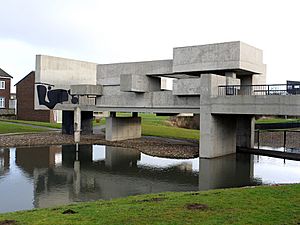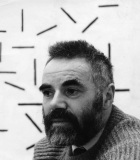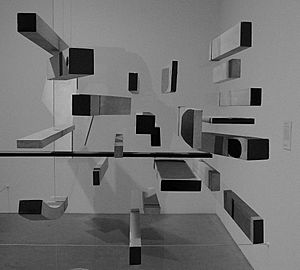Victor Pasmore facts for kids

Edwin John Victor Pasmore (born December 3, 1908 – died January 23, 1998) was a famous British artist. He was a pioneer in developing abstract art in Britain. This means he helped introduce and popularize art that doesn't show real-life objects, but uses shapes, colors, and lines instead. He was active in the 1940s and 1950s.
Contents
Early Life and Education
Victor Pasmore was born in Chelsham, Surrey, England, on December 3, 1908. He went to Summer Fields School in Oxford and Harrow School in west London. After his father passed away in 1927, Victor had to get a job. He worked in an office for the London County Council.
Even with his job, he still loved art. He studied painting part-time at the Central School of Art. For a while, he painted scenes of the River Thames. These paintings looked a bit like the works of famous artists Turner and Whistler.
During the Second World War, Pasmore had strong beliefs against fighting. He was a conscientious objector, meaning he refused to join the military. He was called up for service in 1942 but refused to follow orders. Because of this, he was put in prison for a short time. Later, he was given permission to be excused from military service.
Artistic Journey
Early Art: Figurative Style (1927–1947)
One of Victor Pasmore's first art shows was in London in 1934. His early paintings were inspired by artists like Monet and Cézanne. These artists often painted real-life scenes, like landscapes or people.
Moving to Abstract Art (1948–1954)
Around 1947, Pasmore started to change his style. He became very interested in abstract art. He was inspired by artists like Piet Mondrian and Paul Klee. These artists believed that art could create a sense of balance and harmony using shapes and colors.
Pasmore became a key figure in bringing back Constructivism in Britain after the war. Constructivism is an art style that uses geometric shapes and industrial materials. His abstract works often used collage and built-up shapes, sometimes on a very large scale. A famous art critic, Herbert Read, called Pasmore's new style "the most revolutionary event in post-war British art."
In 1950, he was asked to design an abstract mural for a bus station. The next year, he created another mural for the Festival of Britain. This helped show off the work of other British Constructivist artists.
Pasmore also supported other artists. He helped Richard Hamilton get a teaching job. He also created an abstract structure for an art show called "This Is Tomorrow." He was asked to make a mural for the new Newcastle Civic Centre.
His interest in mixing art with architecture grew. In 1955, he became a special advisor for architectural design in Peterlee. This town's main feature became an abstract public artwork he designed, called the Apollo Pavilion. Some people in the town didn't like it at first. But Pasmore always defended his work. The Pavilion was later fixed up in 2009 with help from a special fund.
Pasmore represented Britain at a big art show called the Venice Biennale in 1961. He also showed his art at Documenta II in 1959. He was a trustee of the Tate Gallery, which is a famous art museum. He even gave some of his artworks to their collection.
Teaching Art
Victor Pasmore was also a very important teacher. He helped change how art was taught in Britain. From 1943 to 1949, he taught at Camberwell School of Art. He told one of his students, Terry Frost, to learn from famous paintings in the National Gallery instead of just following school rules.
Between 1950 and 1954, he taught at the Central School of Art.
From 1954 to 1961, he was a Master of Painting at Durham University. There, he created a new and exciting art course. It was based on the "basic course" from the Bauhaus, a famous German art school. This new course became a model for art education across the UK.
Personal Life
In 1940, Victor Pasmore married an artist named Wendy Blood. They had two children, a son and a daughter. In 1966, he moved to Malta. He passed away in Gudja, Malta, on January 23, 1998, when he was 89 years old.
Legacy and Art Gallery
Victor Pasmore left behind a great artistic legacy. On November 3, 2014, a special gallery was opened in Malta. It's called the Victor Pasmore Gallery. This gallery shows many of his paintings and sculptures. These artworks were found in his homes in Malta and London. The exhibition mainly features art he created while living in Malta.
See also
 In Spanish: Victor Pasmore para niños
In Spanish: Victor Pasmore para niños
- Abstract painting - a 1998 painting by Pasmore



